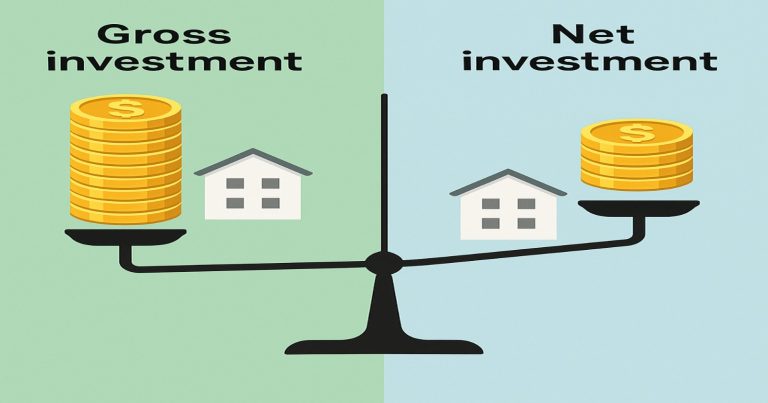Investments constitute an essential part of an economy’s growth and companies’ financial planning. When discussing investments, two important terms keep popping up in the conversation: gross investment and net investment. It is pretty important to clearly understand what sets the two apart since it reveals what is growing in a company’s assets, considering depreciation and the age of the economy. This article digs deeper into the definitions of gross and net investments, including how they are calculated and their advantages. Understanding these concepts also helps policymakers and businesses evaluate true economic progress, forecast future capital needs, and make informed strategic financial decisions.
Difference Between Gross Investment and Net Investment
Gross investment is the total investment into an economy or firm and is not subtracted by any depreciation. This, on the other hand, net investment subtracts depreciation to show a real net increase in productive assets. Gross and net investments are often compared to gauge economic health or a business’s growth. Here’s a detailed look at both:
| Aspect | Gross Investment | Net Investment |
|---|---|---|
| Definition | Total investment without deductions | Investment after accounting for depreciation |
| Purpose | Measures capital creation | Measures net asset increase |
| Calculation | Total capital spending | Gross investment – depreciation |
| Indicator | Shows overall asset purchases | Shows actual capital growth |
| Economic Insight | Highlights gross asset acquisitions | Highlights retained and useful assets |
Gross investment provides a complete picture of total capital spending, while net investment gives a more refined view by showing actual growth after deducting worn-out assets.
What is Gross Investment?
Gross investment is the total amount of expenditure on capital goods, ignoring depreciation. It is the value of the actual cost incurred while acquiring new assets, improving existing ones, or replacing old ones.
Why Gross Investment Matters
Gross investment is an indicator of the level of total economic activity; capital expenditure is at a certain level. A gross investment at a high level usually points to strong economic growth because substantial investments by businesses are being made in their expanding productive capacities.
How to Calculate Gross Investment?
Gross investment calculation is straightforward: it represents all funds invested in new or replacement capital assets before accounting for depreciation.
Gross Investment = Net Investment + Depreciation
For instance, if a company has a net investment of $500,000 and depreciation expenses of $100,000, the gross investment would be:
Gross Investment = 500,000 + 100,000 = 600,000
What is Net Investment?
Net investment adjusts for the depreciation. It shows the real increment in productive assets of the company because it subtracts the loss in value by wearing out the assets.
Importance of Net Investment
Net investment helps in determining the true expansion of capital of an organization. If it is positive, it simply means that the organization is growing since the capital stock is increasing above its depreciation rate. The negative sign may describe shrinkage or underinvestment in the restoration of fixed assets.
How to Calculate Net Investment?
Net investment calculation involves deducting depreciation from gross investment, which provides a clearer view of how much capital is added to an economy or business.
Net Investment = Gross Investment – Depreciation
Example: If a gross investment is $600,000 and depreciation is $100,000, the net investment would be:
Net Investment = 600,000 – 100,000 = 500,000
Advantages of Net Investment
Net investment holds several advantages, especially for financial analysis and economic forecasting.
- Reflects True Growth: Net investment accounts for depreciation, reflecting true growth in productive assets.
- Improves Financial Analysis: Investors and analysts have net investment more, preferably as it gives a real measure of asset growth of the organization.
- Economic Health Indicator: A positive net investment relates to the development and growth of economies, while a negative number can imply stagnation or a recession.
Gross Investment and Net Investment FAQ
What is the difference between gross investment and net investment?
Gross investment is the total capital investment in an economy or business, including replacement of worn-out assets, while net investment adjusts for depreciation, showing actual capital growth. Gross investment can give a higher figure, but net investment reflects true asset increase.
How do you calculate net investment from gross investment?
To calculate net investment, subtract depreciation from gross investment. For instance, if gross investment is $1 million and depreciation is $200,000, net investment equals $800,000, representing actual growth.
Why is net investment important?
Net investment is essential as it shows the true increase in productive capacity after accounting for asset wear. Positive net investment suggests economic or business growth, while negative values can indicate reduced capital stock.
What does a negative net investment mean?
Negative net investment means depreciation exceeds gross investment, implying that the existing capital stock is shrinking. It can be a sign of underinvestment in asset renewal or economic slowdown.
Is gross investment always greater than net investment?
Generally, yes, gross investment includes all capital expenses without deductions, while net investment factors in depreciation. However, if depreciation is zero, gross and net investments would be equal, though this is rare in real-world scenarios.


